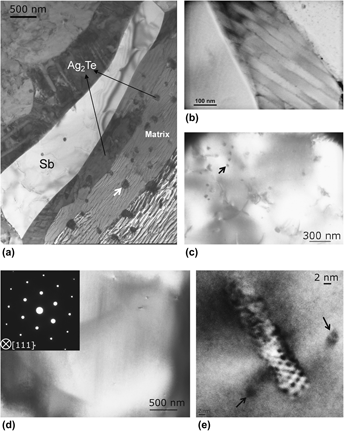Crossref Citations
This article has been cited by the following publications. This list is generated based on data provided by
Crossref.
Dadda, Jayaram
Müller, Eckhard
Klobes, Benedikt
Bauer Pereira, Paula
and
Hermann, Raphael
2012.
Electronic Properties as a Function of Ag/Sb Ratio in Ag1−y Pb18Sb1+z Te20 Compounds.
Journal of Electronic Materials,
Vol. 41,
Issue. 8,
p.
2065.
Ikeda, Teruyuki
Iwanaga, Shiho
Wu, Hsin-jay
Marolf, Nathan J.
Chen, Sinn-wen
and
Snyder, G. Jeffrey
2012.
A combinatorial approach to microstructure and thermopower of bulk thermoelectric materials: the pseudo-ternary PbTe–Ag2Te–Sb2Te3 system.
Journal of Materials Chemistry,
Vol. 22,
Issue. 46,
p.
24335.
Perlt, S.
Höche, Th.
Dadda, J.
Müller, E.
Bauer Pereira, P.
Hermann, R.
Sarahan, M.
Pippel, E.
and
Brydson, R.
2012.
Microstructure analyses and thermoelectric properties of Ag1−xPb18Sb1+yTe20.
Journal of Solid State Chemistry,
Vol. 193,
Issue. ,
p.
58.
Perlt, S.
Höche, Th.
Dadda, J.
Müller, E.
and
Rauschenbach, B.
2013.
Compositional Sensitivity of Microstructures and Thermoelectric Properties of Ag1−x Pb18Sb1+y Te20 Compounds.
Journal of Electronic Materials,
Vol. 42,
Issue. 7,
p.
1422.
Bauer Pereira, Paula
Sergueev, Ilya
Gorsse, Stéphane
Dadda, Jayaram
Müller, Eckhard
and
Hermann, Raphaël P.
2013.
Lattice dynamics and structure of GeTe, SnTe and PbTe.
physica status solidi (b),
Vol. 250,
Issue. 7,
p.
1300.
Ni, Jennifer E.
and
Case, Eldon D.
2013.
Thermal Fatigue of Cast and Hot-Pressed Lead-Antimony-Silver-Tellurium (LAST) Thermoelectric Materials.
Journal of Electronic Materials,
Vol. 42,
Issue. 7,
p.
1382.
Ziolkowski, Pawel
Karpinski, Gabriele
Dasgupta, Titas
and
Müller, Eckhard
2013.
Probing thermopower on the microscale.
physica status solidi (a),
Vol. 210,
Issue. 1,
p.
89.
Amouyal, Yaron
2013.
On the role of lanthanum substitution defects in reducing lattice thermal conductivity of the AgSbTe2 (P4/mmm) thermoelectric compound for energy conversion applications.
Computational Materials Science,
Vol. 78,
Issue. ,
p.
98.
Neubrand, A.
Dadda, J.
Mueller, E.
Perlt, S.
and
Höche, T.
2013.
Spatially Resolved Thermal Conductivity Measurements Using a Thermoreflectance Microprobe.
Journal of Electronic Materials,
Vol. 42,
Issue. 7,
p.
2165.
Amouyal, Yaron
2014.
Reducing Lattice Thermal Conductivity of the Thermoelectric Compound AgSbTe2 (P4/mmm) by Lanthanum Substitution: Computational and Experimental Approaches.
Journal of Electronic Materials,
Vol. 43,
Issue. 10,
p.
3772.
Dadda, Jayaram
Müller, Eckhard
Perlt, Susanne
Höche, Thomas
Hermann, Raphael
and
Neubrand, Achim
2014.
Evolution of phase segregation and eutectic structures in AgPb18SbTe20.
physica status solidi (a),
Vol. 211,
Issue. 6,
p.
1276.
Bellanger, Philippe
Gorsse, Stéphane
Bernard-Granger, Guillaume
Navone, Christelle
Redjaimia, Abdelkrim
and
Vivès, Solange
2015.
Effect of microstructure on the thermal conductivity of nanostructured Mg2(Si,Sn) thermoelectric alloys: An experimental and modeling approach.
Acta Materialia,
Vol. 95,
Issue. ,
p.
102.
Lu, Ping
Liu, Huili
Yuan, Xun
Xu, Fangfang
Shi, Xun
Zhao, Kunpeng
Qiu, Wujie
Zhang, Wenqing
and
Chen, Lidong
2015.
Multiformity and fluctuation of Cu ordering in Cu2Se thermoelectric materials.
Journal of Materials Chemistry A,
Vol. 3,
Issue. 13,
p.
6901.
Horichok, Ihor
Ahiska, Rasit
Freik, Dmytro
Nykyruy, Lyubomyr
Mudry, Stepan
Matkivskiy, Ostap
and
Semko, Taras
2016.
Phase Content and Thermoelectric Properties of Optimized Thermoelectric Structures Based on the Ag-Pb-Sb-Te System.
Journal of Electronic Materials,
Vol. 45,
Issue. 3,
p.
1576.
Zou, Minmin
Liu, Qing
Wu, Chao-Feng
Wei, Tian-Ran
Tan, Qing
Li, Jing-Feng
and
Chen, Fei
2018.
Comparing the role of annealing on the transport properties of polymorphous AgBiSe2 and monophase AgSbSe2.
RSC Advances,
Vol. 8,
Issue. 13,
p.
7055.
Ziolkowski, Pawel
Wambach, Matthias
Ludwig, Alfred
and
Mueller, Eckhard
2018.
Application of High-Throughput Seebeck Microprobe Measurements on Thermoelectric Half-Heusler Thin Film Combinatorial Material Libraries.
ACS Combinatorial Science,
Vol. 20,
Issue. 1,
p.
1.
Li, Yaqin
Ma, Baopeng
Zhu, Lujun
Liu, Shixuan
Zhang, Fudong
Li, Xiaojun
Liang, Pengfei
Chao, Xiaolian
Yang, Zupei
He, Jiaqing
and
Wu, Di
2022.
Identifying polymorphic lattice positioning of copper and the effects on the thermoelectric performance of δ-LAST.
Materials Today Physics,
Vol. 27,
Issue. ,
p.
100833.
Ma, Baopeng
Li, Yaqin
Zhu, Lujun
Zhang, Fudong
Li, Xiaojun
Shi, Yalin
Liang, Pengfei
Peng, Zhanhui
Chao, Xiaolian
Yang, Zupei
and
Wu, Di
2024.
Modulation doping promoted ultrahigh electron mobility and enhanced thermoelectric performance in PbTe.
Chemical Engineering Journal,
Vol. 488,
Issue. ,
p.
150647.





